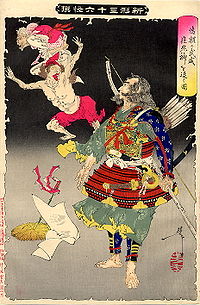
Minamoto no Tametomo
Encyclopedia

Hogen Rebellion
The was a short civil war fought in order to resolve a dispute about Japanese Imperial succession. The dispute was also about the degree of control exercised by the Fujiwara clan who had become hereditary Imperial regents during the Heian period....
of 1156. He was the son of Minamoto no Tameyoshi
Minamoto no Tameyoshi
was head of the Minamoto samurai clan during his lifetime, and grandson of Minamoto no Yoshiie; he led the Minamoto in the Hōgen Rebellion. Tameyoshi is also known as ....
, and brother to Yukiie
Minamoto no Yukiie
was the brother of Minamoto no Yoshitomo, and one of the commanders of the Minamoto forces in the Genpei War at the end of the Heian period of Japanese history....
and Yoshitomo
Minamoto no Yoshitomo
was the head of the Minamoto clan and a general of the late Heian period of Japanese history. His son Minamoto no Yoritomo became shogun and founded the Kamakura Shogunate, the first shogunate in the history of Japan.-Hōgen Rebellion:...
.
In the Hōgen Rebellion, he fought to defend the Shirakawa-den
Siege of Shirakawa-den
The siege of the Shirakawa-den was the central event of the Hōgen Rebellion, a succession dispute which broke out after the death of the cloistered Emperor Toba...
, alongside his father, against the forces of Taira no Kiyomori
Taira no Kiyomori
was a general of the late Heian period of Japan. He established the first samurai-dominated administrative government in the history of Japan.After the death of his father Taira no Tadamori in 1153, Kiyomori assumed control of the Taira clan and ambitiously entered the political realm in which he...
and Minamoto no Yoshitomo
Minamoto no Yoshitomo
was the head of the Minamoto clan and a general of the late Heian period of Japanese history. His son Minamoto no Yoritomo became shogun and founded the Kamakura Shogunate, the first shogunate in the history of Japan.-Hōgen Rebellion:...
, his brother. The palace was set aflame, and Tametomo was forced to flee and was banished to the island of Ōshima
Izu Oshima
is a volcanic island in the Izu Islands and administered by the Tokyo Metropolitan government, Japan, lies about 100 km south of Tokyo, 22 km east of the Izu Peninsula and 36 km southwest of Bōsō Peninsula. serves as the local government of the island...
in the Izu Islands
Izu Islands
The are a group of volcanic islands stretching south and east from the Izu Peninsula of Honshū, Japan. Administratively, they form two towns and six villages; all part of Tokyo. The largest is Izu Ōshima, usually called simply Ōshima....
. In Ryūkyū
Ryukyu Islands
The , also known as the , is a chain of islands in the western Pacific, on the eastern limit of the East China Sea and to the southwest of the island of Kyushu in Japan. From about 1829 until the mid 20th century, they were alternately called Luchu, Loochoo, or Lewchew, akin to the Mandarin...
, it has long been believed that he made his way down to Okinawa during his exile, and founded their kingdom by siring the first king of Chūzan
Chuzan
Chūzan was one of three kingdoms which controlled Okinawa in the 14th century. Okinawa, previously controlled by a number of local chieftains or lords, loosely bound by a paramount chieftain or king of the entire island, split into these three more solidly defined kingdoms within a few years after...
, Shunten
Shunten
' was a king of the Ryūkyū Islands.Shunten is the earliest king in Okinawa for whom a name is known. He is said to have taken power after defeating a usurper to the throne by the name of Riyū who had overthrown the 25th king of the Tenson Dynasty....
. This tale was included in Chūzan Seikan by Shō Shōken
Sho Shoken
Shō Shōken , also known as Haneji Chōshū , was a Ryūkyūan scholar and served as sessei, a post often translated as "prime minister," from 1666 to 1673...
, the first history of Ryūkyū.

In 1170, as the conflict between the Minamoto and Taira continued, Tametomo became surrounded by enemy Taira warriors on a small island. In some legends, it is said that Taira cut the tendons of Tametomo's left arm. Thinking that he wouldn't be able to fight anymore, he killed himself by slicing his abdomen, or committing seppuku
Seppuku
is a form of Japanese ritual suicide by disembowelment. Seppuku was originally reserved only for samurai. Part of the samurai bushido honor code, seppuku was either used voluntarily by samurai to die with honor rather than fall into the hands of their enemies , or as a form of capital punishment...
. He is quite possibly the first warrior to commit seppuku
Seppuku
is a form of Japanese ritual suicide by disembowelment. Seppuku was originally reserved only for samurai. Part of the samurai bushido honor code, seppuku was either used voluntarily by samurai to die with honor rather than fall into the hands of their enemies , or as a form of capital punishment...
in the chronicles.
The story of Tametomo founding a kingship in Okinawa while in exile is most likely untrue, and most historians today discount this entire story as a later invention, a piece of a revisionist history intended to legitimize Japanese domination over Okinawa and/or Okinawan membership in the Japanese nation. A similar story exists on the island of Amami Ōshima
Amami Oshima
is a semi-tropical island in the Amami Islands, which is part of the larger Nansei Islands in Japan. Ōshima literally means big island, and it is the largest of the Amami Islands. It lies roughly halfway between the islands of Okinawa and Kyūshū. Briefly part of the Ryūkyū Kingdom, in 1624 it was...
, however.

